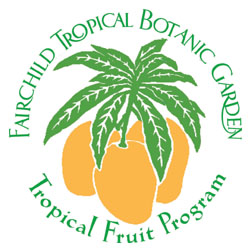
Making Magic with Mangos
Noris Ledesma, Curator of Tropical Fruit

Methods of Home Preservation of Fruit
With mango season close at hand, we are all thinking about that age-old question: how to deal with all those glorious, delicious ó and ripe ó mangos. These are the tricks of the trade in handling the mango harvest from Fairchild Tropical Botanical Garden, where we convert the produce from our fruit collections into wondrous magic. Learn how to make a wide range of mango products, which are the backbone of the International Mango Festival. Learn the basics of preparing and freezing pulp, making juices and jams, and much more.
This section will discuss various ways that fruits can be preserved in the home. One of the advantages of preserving fruits is to have them available for consumption over a longer period of time. By preserving fruit, one is able to utilize all of the fruit in a single season. The following methods to do not require sophisticated equipment and can be accomplished using basic equipment found in the home.
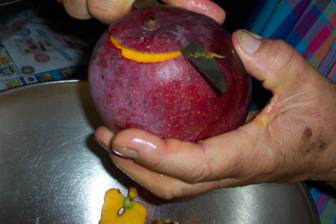
Drying Mangos
Drying is an excellent way to preserve fruit. Dried slices or “fruit leather” are two options to make delicious, sweet, all-natural snacks. There are several advantages to drying including; ease in preparation, and the fact that pre-treatment of the fruit is not necessary.
Drying is the oldest method of preserving fruit. Originally, fruits were left out in the sun to dry. Later, people began drying fruit over fire. Now, most drying is done in stoves or ovens. Commercial dehydrators are also available for home use.
Many fruits can be preserved by dehydration. Several types that are easily dried include: apples, peaches, apricots, and mangos (which are perhaps the most popular). However, with a little experimentation, many of our South Florida tropical fruits work equally well.
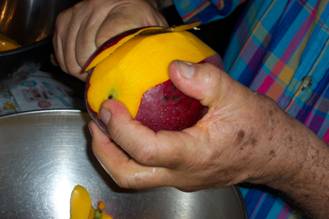
Dehydrators:
Several good commercial dehydrators are available for home use. The best machines have an electric heating element with temperature controls, and fans that assure uniform temperature distribution in the drying chamber. Teflon mesh trays are preferable because the dried fruit slices do not sick to them.
A household oven (electric or gas) can be used if the temperature can be set low enough to prevent darkening of the fruit. A convection oven works almost like an electric dehydrator.
Dehydrating Mangos:
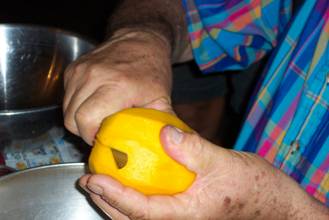
Procedure:
Select quality fruit: Select firm, ripe fruit. Carefully wash and peel the fruit.
Cut the fruit: Cut the pulp into lengthwise slices up to an inch in thickness.
Place the trays in the dehydrator: Arrange the slices flat on the dehydrating trays. Be careful not to clump the fruit slices together.
Temperature: Set the temperature control from 125° to 135°F, and let it run until the slices reach the desired consistency. Slices that are too soft or moist do not store well. Drying time depends upon the thickness of the slices, the amount of fruit in the dehydrator and the humidity. In South Florida, drying times depends on the ambient temperature and atmospheric humidity. The relative amount of moisture in the fruit, and the thickness of fruit are also important to consider.
Mango leather
Mango leather is an excellent alternative to make a delicious candy. Kids love it!
Select fully ripe fruit that is in season. This is a good way to use culls or slightly bruised fruit. The pulp should be soft enough to puree easily. In a blender or food mill, process the peeled and pitted pulp to a smooth puree. No additives are needed. Place the plastic wrap or wax paper on the dehydrator trays. Spread the puree about an inch thick. Place the trays in the dehydrator with the temperature set to 125°F to 130°F. Turn on the dehydrator and let it run until the leather has reached a firm, elastic, sticky consistency, usually about 8 to 10 hours. The leather is finished when the dried pulp can be easily peeled from the plastic. Dried mango leather is usually a darker color than dried slices. Remove leather from the trays and roll it up in the plastic sheets. Uncovered leather rolls will stick together.
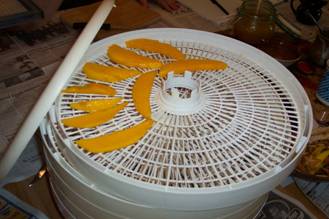
Advantages of dry fruit:
- This healthy snack contains fiber, vitamins and minerals.
- Most people like it
- Drying does not change the flavor of the natural fruit
- In many fruit the color retention is excellent
- Fruit can be stored in a small space
- Dried fruit makes beautiful crafts and gifts
Packaging dry fruit for storage:
Dried fruit slices and fruit leather should be sealed in bags soon after drying or they will take up moisture and soften considerably. For best storage, dried fruit can be kept in the refrigerator for at least three years. Do not store them at room temperature for more than a few days, they will ferment or mold.
Canning Mangos
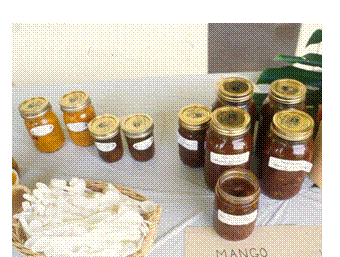
Canning involves the natural enzymatic breakdown of fruit by heating fruits in a liquid medium inside a closed container. This method requires more knowledge of food preservation. The recommended method of canning fruit is the water-bath.
PH: Fruits with a pH of 4.0 to 4.5 (such as mangos, papayas, figs) should have acid added to packing medium to obtain a pH below 4.0.† One-fourth cup lime or lemon juice per pint is enough to make the needed pH adjustment.
Processing fruit: Fruit and all the equipment to be used should be washed thoroughly prior to commencing work. It is preferable to use fresh fruit over frozen. Make sure to remove all seeds first.
Jellies, jams, butters, marmalades and preserves are fruit preserved with sugar and usually jelled to some extent. Their individual characteristics depend on the kind of fruit used, the mixture, and the method of cooking.
Cooking times and methods vary according to the product being made.† When making preserves without commercial pectin, combine the fruit or juice with sugar and cook to the
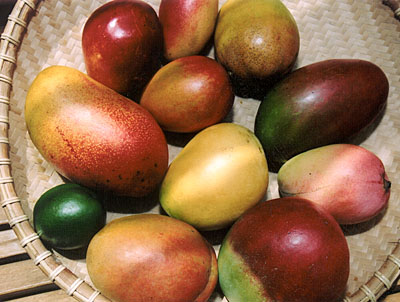
Jelly: is made from fruit juice and should be clear and tender, yet firm enough to holds its shape.
Jam: is made from crushed or ground fruit. It is smooth and thick, slightly softer than jelly and still holds itís shape.
Butter: is made of fruit pulp that is cooked to a smooth and very thick consistency. It can be sweet or spiced.
Marmalade: is made of pieces of fruit pulp and rind evenly suspended throughout a clear jelly. Citrus fruits are commonly used, either alone or in combination with other fruits.
The temperature or consistency recommended, or to the jelly point. If you like your product firmer, lengthen the cooking time, for a softer product, shorten it. Overcooking it is also causes darkening of preserves and a taste and odor of caramelized sugar. Be careful not to overcooking the fruit.
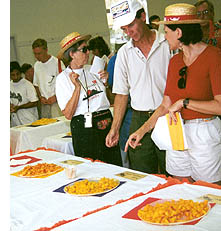
Preserves: are whole fruits or large pieces of fruit cooked in thick sugar syrup until the fruit is tender and somewhat transparent in appearance.
Sterilization: The objective here, is to destroy bacteria and other microorganisms that may spoil food, by heating the mixture. Special canning jars with self-sealing lids should be washed in hot soapy water. Lids must be new. Place clean jars in a large pot, cover with water and bring to a boil. Boil jars for at least 10 minutes to sterilize.

Filling and sealing jars: When the fruit is ready for canning, remove a hot, sterile jar from the water with tongs, and ladle the fruit into the jar. After jars are filed, wipe away anything on the threads of the jar, or anything that has spilled on the outside with a clean damp cloth. Place lid on jar and screw tightly. Invert jar for about 30 seconds so hot jelly can destroy molds or yeast, which may have settle on the lid. Return jar to an upright position and allow it to cool. When the jar has completely cooled, check the seal to be sure it is secure. If the center of the lid is indented slightly, the jar is sealed.
Most often the seal is completed as the jar cools, and you will hear a familiar “ping” sound as the center of the lid inverts when a vacuum is formed. If the seal is not complete, bring the contents of the jar to a boil and re-pack using a clean, hot, sterile jar and a new lid.
Freezing Mangos
Freezing mangos is accomplished by storing fruit at temperatures bellow 32°F. This limits the enzymatic breakdown of the fruit. Mangos can be frozen without any special treatment except washing, while some fruits need to be peeled or seeded. Still others need to be treated with ascorbic acid to prevent darkening. Frozen fruit looks and tastes very similar to fresh fruit.